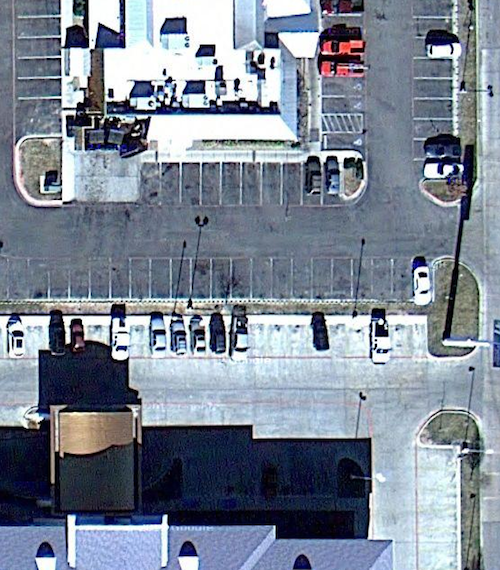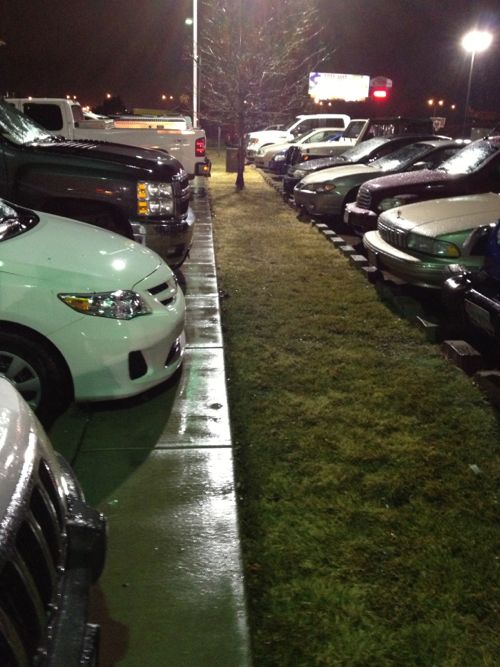Walking From Hotel To Restaurant
In September 2010 I posted about the disconnect between a hotel and restaurant in Joplin (see Driving Next Door For Dinner) where I said the design made it difficult if someone wanted to walk next door for dinner after they checked into their room. Last week this hypothetical situation became reality in Amarillo Texas.
I was in Amarillo TX for the funeral of an 80 year old uncle, seven of us were staying in the same Holiday Inn Express. After the service some went back to the hotel to rest, my brother and I to check in. Three other relatives were going to come over to the hotel and the ten of us would walk together to the Texas Roadhouse restaurant, conveniently located right in front. This proved easier said than done.

In my family I’m younger than all my cousins — by up to 19 years. Still, I’m the only one that walks with a cane. Our aunts and uncles are now in their 70s and 80s — one aunt will be 90 in a few months. Our group of ten was seven cousins, two aunts & an uncle. An aunt & uncle, both in their 80s, require help to walk steady on level ground. Especially to cross an obstacle course like the one we encountered.

I suppose the three of us could’ve gotten in a car to drive from one side of the divider (above) to the other side, but that shouldn’t be necessary. The point where we crossed going to dinner the step down from the sidewalk to the grass was taller than most curbs. Returning to the hotel we found a spot that wasn’t so bad. I suppose we could’ve walked around this barrier but that would’ve put us in a busy drive and meant walking a greater distance, a problem for all three of us.
We’ve built so much in every city like this that requires a car to get anywhere, even next door. I hope to live long enough to see the day when this is no longer the norm.
— Steve Patterson
They probably have a high curb to discourage the good folks of Texas not to drive over the curb with their trucks.
You’re assuming that one or both property owners have any desire to encourage direct pedestrian (or vehicular) access across their shared property line. The most likely answer is either “no” or “we just didn’t think about it”. Private property, even those offering public accommodations, remains private property and are free to limit access to/from the public right-of-way and within the the limits of the law. And, it is not surprising for adjacent commercial properties to limit access IF they expect that their property will be used without compensation for the benefit of the adjacent property. Every business decision boils down to a cost-versus-benefit analysis. Does the added cost of providing a defined, accessible pedestrian connection result in in more customers and more revenue? What new liabilities are created? Or, will “enough” customers show up in spite of these intended or unintended barriers?
The reality is that the only “barrier” here is a curb (required for drainage and to keep vehicles off the grass), grades and grass (likely required under Amarillo zoning) – it presents no barrier for most people. While it presents a small barrier for the disabled and the elderly, and given the reality that the restaurant and the motel were constructed at different times by different owners, what would you propose as a real, repeatable solution? Yes, a public sidewalk would keep you out of the busy drive, but that’s a whole ‘nuther issue and it would do absolutely nothing to address the long, roundabout issue that is the point of today’s post. Should we require all adjoining (commercial? all?) property owners enter into and maintain, in perpetuity, cross-access agreements for both vehicles and pedestrians? Should we outlaw “spite fences”, like the one Hardee’s built at Hampden & I-44 when the Wendy’s was built next door? And, should the first property owner be required to make modifications to conform to the subsequent property owners’ plans? (For the first owner, Murphy’s Law says that whatever educated guess you make, odds are that it will likely be wrong and have to be redone!)
Yes, most pedestrians will choose the shortest path between two points, and most will make educated choices based on topography and barriers. Yes, it’s much more difficult for people with disabilities to navigate changes in grade. I get it, but life’s not fair. The ONLY way to make the world ideal for people with disabilities would be to make it all hard and flat, and that ain’t gonna happen! Barriers are installed for a reason. Better thinking and planning can make some go away, but most will need to remain . . .
JZ,
It’s quite simple, really. You need two basic things to make sure anyone (including those in wheelchairs, with canes or strollers, etc) can get next door (or just about anywhere) under their own steam provided they have the energy:
1. A public sidewalk along the street (with accessible curb ramps and safe street crossings).
2. A legal requirement that developers provide a safe, relatively direct, and barrier-free pedestrian path from the main entrance of a commercial establishment to the sidewalk. It’s really the least that can be expected when zoning regulations in most communities already specify how many parking spaces a business must have, how large the spaces are, how wide the aisles are, etc.
Now, there are other things you could do to make this environment more pedestrian friendly – for example, those buildings are probably subject to a minimum setback requirement from the street. But if you were to eliminate that, or even set a maximum setback, then the buildings can be built right up close to the sidewalk. Bingo! Walk out the front door of your hotel, down the sidewalk, and in the front door of the restaurant!
Agree, completely, but that was not the point Steve was making – he thinks that there should be a direct path (“short cut”) between the front door of the Holiday Inn and the front door of the Texas Roadhouse, one that does not require using the public sidewalk (if provided) or the public right-of-way AND one that is handicapped accessible! Would one be “nice”? Absolutely! Would it be used daily? Probably. The “problem” is making it happen without the government forcing it to happen. The “problem” is that both businesses did their site design in a vacuum. The “problem” is that the larger development’s design criteria does not require individual users to coordinate with each other. It’s going to take a combination of better design, at multiple levels, and developers interested in more than just the bottom line to see any real changes. What happened here is no different than what one finds in many, may other locations, including the St. Louis region. There is no easy answer, since it’s very difficult to legislate / mandate good / better design, especially among distinct applicants and permits.
Does it really matter? American Culture has been captured by the oil and concrete cartels. It is the same bullshit over and over with the main stream media trying to rationalize the greed of a few.
In a normal capitalistic society, connections between hotel and restaurant are celebrated, it means business and customers. In America only cars are allowed. Mostly it benefits the Fred Weber’s and Koch Bros of the world through monopolies like Exxon, Ameren and the rest.
How in the world are there not glorious connections between the hotel and a restaurant next door? Is it stupidity or greed?
They are the masters. Neither Reed nor Slay have said a word about city planning and resolving problems like this. Why is that?
At a minimum America is populated with mediocre architects and politicians. You want more evidence? Go outside your door. If you do not live in an historic part of the city and region then architecture and city planning has failed you. It has mostly failed historic areas also, through transit and the hacking away of the walk ability of neighborhoods.
Steve has brought this to everyone’s attention, but let’s be honest, similar examples are endless.
(A side note, there are cuts to education, health and so on, but the Missouri state legislature thinks they can find another billion dollars for transportation on top of the 600 million they already receive) Just what the world needs, more spending on auto’s at the expense of the rest of civilization. But hey, Fred Weber, the Koch Bros and their buddies are doing well.
You wouldn’t think they influence public policy in their favor, do you?